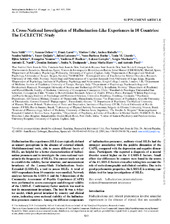| dc.contributor.author | Siddi, Sara | |
| dc.contributor.author | Ochoa, Susana | |
| dc.contributor.author | Larøi, Frank | |
| dc.contributor.author | Cella, Matteo | |
| dc.contributor.author | Raballo, Andrea | |
| dc.contributor.author | Saldivia, Sandra | |
| dc.contributor.author | Quijada, Yanet | |
| dc.contributor.author | Laloyaux, Julien Freddy | |
| dc.contributor.author | Rocha, Nuno Barbosa | |
| dc.contributor.author | Lincoln, Tania M. | |
| dc.contributor.author | Schlier, Björn | |
| dc.contributor.author | Ntouros, Evangelos | |
| dc.contributor.author | Bozikas, Vasileios P. | |
| dc.contributor.author | Gawęda, Łukasz | |
| dc.contributor.author | Machado, Sergio | |
| dc.contributor.author | Nardi, Antonio E. | |
| dc.contributor.author | Rodante, Demián | |
| dc.contributor.author | Deshpande, Smita N. | |
| dc.contributor.author | Haro, Josep Maria | |
| dc.contributor.author | Preti, Antonio | |
| dc.date.accessioned | 2020-04-08T10:26:57Z | |
| dc.date.available | 2020-04-08T10:26:57Z | |
| dc.date.issued | 2019-02-01 | |
| dc.Published | Siddi S, Ochoa S, Larøi F, Cella M, Raballo A, Saldivia, Quijada, Laloyaux JF, Rocha, Lincoln TM, Schlier B, Ntouros, Bozikas, Gawęda, Machado, Nardi, Rodante, Deshpande, Haro JM, Preti A. A cross-national investigation of hallucination-like experiences in 10 countries: The E-CLECTIC Study. Schizophrenia Bulletin. 2019;45:S43-S55 | eng |
| dc.identifier.issn | 0586-7614 | |
| dc.identifier.issn | 1745-1701 | |
| dc.identifier.uri | https://hdl.handle.net/1956/21829 | |
| dc.description.abstract | Hallucination-like experiences (HLEs) are typically defined as sensory perceptions in the absence of external stimuli. Multidimensional tools, able to assess different facets of HLEs, are helpful for a better characterization of hallucination proneness and to investigate the cross-national variation in the frequencies of HLEs. The current study set out to establish the validity, factor structure, and measurement invariance of the Launay-Slade Hallucinations Scale-Extended (LSHS-E), a tool to assess HLEs. A total of 4419 respondents from 10 countries were enrolled. Network analyses between the LSHS-E and the 3 dimensions of the Community Assessment of Psychic Experiences (CAPE) were performed to assess convergent and divergent validity of the LSHS-E. Confirmatory factor analysis was used to test its measurement invariance. The best fit was a 4-factor model, which proved invariant by country and clinical status, indicating cross-national stability of the hallucination-proneness construct. Among the different components of hallucination-proneness, auditory-visual HLEs had the strongest association with the positive dimension of the CAPE, compared with the depression and negative dimensions. Participants who reported a diagnosis of a mental disorder scored higher on the 4 LSHS-E factors. Small effect size differences by country were found in the scores of the 4 LSHS-E factors even after taking into account the role of socio-demographic and clinical variables. Due to its good psychometric properties, the LSHS-E is a strong candidate tool for large investigations of HLEs. | en_US |
| dc.language.iso | eng | eng |
| dc.publisher | Oxford University Press | eng |
| dc.rights | Attribution CC BY-NC 4.0 | eng |
| dc.rights.uri | http://creativecommons.org/licenses/by-nc/4.0/ | eng |
| dc.subject | hallucination proneness | eng |
| dc.subject | cross-national | eng |
| dc.subject | measurement invariance | eng |
| dc.title | A cross-national investigation of hallucination-like experiences in 10 countries: The E-CLECTIC Study | eng |
| dc.type | Peer reviewed | |
| dc.type | Journal article | |
| dc.date.updated | 2019-11-15T10:09:23Z | |
| dc.description.version | publishedVersion | |
| dc.rights.holder | Copyright 2019 The Author(s) | eng |
| dc.identifier.doi | https://doi.org/10.1093/schbul/sby156 | |
| dc.identifier.cristin | 1694625 | |
| dc.source.journal | Schizophrenia Bulletin | |

